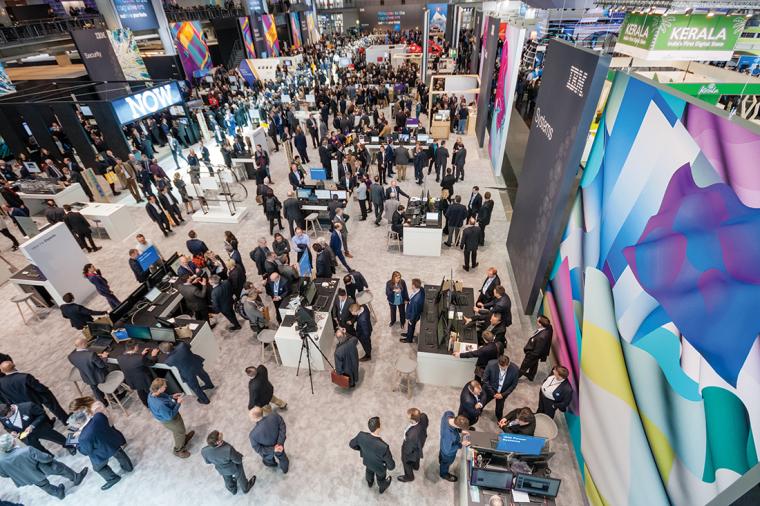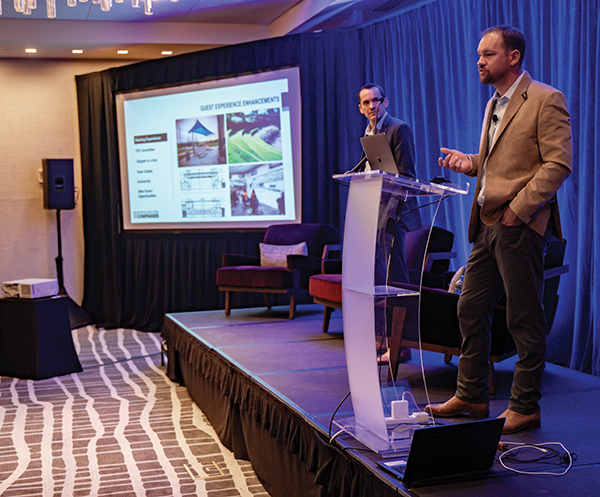
Trade shows and expos are perhaps one of the most popular add-ons to any sports event. In addition to giving vendors exposure to a guaranteed population of athletes and sports enthusiasts, they provide a great social hub, and they increase economic impact for the overall event. They’re also a great place for athletes to learn about the latest equipment and technology on the market Win/win/win/win, right?
Well, they can be, provided you take the right approach to planning. After all, while your event may last a day, a weekend or even longer, organizing a trade show should start months in advance. Here are some points to consider, gleaned from our years of putting on the U.S. Sports Congress.
As a quick background, the U.S. Sports Congress is held each December in rotating locations, to serve the sports business industry. Attendees include rights holders and event owners, national governing bodies and destinations and venues that want to connect with them. We also put on the Collegiate Championship Symposium, helping connect event owners at the university level with the cities and facilities that are interested in hosting.

We have an unusual conference model in that we don’t schedule appointments, but instead, allow attendees to visit with those they want. We try to manage our registration numbers in order to create an environment that is conducive to getting to know others in the industry. But we still do have an exhibit hall, and from more than a decade of experience with it, we have developed some best practices. If you’re considering adding an expo or trade show to your event, here are some guidelines.
Consider the Footprint of Your Exhibit Area: The amount of space you have will determine how many booths, table-top displays or other exhibit areas you can accommodate. Remember that some exhibitors may want to go all out, bringing in large and elaborate displays and themed materials, while others will need only a small space.
Exhibit Hall Management: Trade show companies specialize in exhibit hall set-up, including supplying tables, chairs, pipe and drape, carpeting and other furnishings. The company you work with will be able to let you know what will fit in a given space (and how) – but you will have to provide them with an estimate of the number of exhibitors you are expecting, and what they’ll be looking for, space-wise. Be realistic with your numbers but remember: if you have to create extra space late in the game, it becomes a logistical challenge, which translates into extra expense.
Be specific about measurements when renting from the company. Are the tables six feet or eight feet long? What is the baseline for what an exhibitor gets? An example might be a covered table, pipe and drape, an electrical outlet, a specific number of chairs and a wastepaper basket. Don’t forget to budget for daily vacuuming and trash removal.
Retain a Good Shipping and Logistics Partner: Make sure you contract with a company that will be responsible for receiving exhibitors’ materials and placing them where they need to be. Some show decorating companies also offer shipping and logistics services. Most event owners with a trade show component prefer to have the exhibit and/or shipping company maintain a physical presence onsite throughout the show to handle any needs or problems; if this is what you want, make sure to specify it in all documentation.
If exhibitors will require professional set-up or construction/assembly experience of large displays, this may be outside the scope of responsibility for the trade show or logistics company; ascertain that all messaging is very clear on what services the shipper/trade show company will provide vs. what the exhibitor should be ready to do.
Invariably, you’ll have some exhibitors who need to leave early (no matter what your materials say about not doing so). Having the trade show/shipping partner onsite will allow this to go seamlessly and quickly, with less disruption to the rest of the exhibitors and attendees.

Hours of Operation and Staffing: Will your trade show be open throughout the course of the event, or just during certain times? Will there be staff members or security personnel onsite? What are their hours and responsibilities? We can’t count the number of times someone has asked if we would keep an eye on their laptop or other equipment for them because they wanted to step away from their exhibit for a while. (Our default is to advise them to take equipment with them.) Remember that staffing and security will add additional costs to your bottom line.
Be Ready for Snafus: Having people onsite to handle questions about shipping and logistics, as well as about the event itself, is essential. Forms for trade show registration may be filled out at the corporate office of the exhibitor, but the representatives who come to the show may not be the same people who made the arrangements and thus may not be aware of the instructions. They may ship their booth to the hotel where they are staying instead of to the logistics company, or they may have other needs that will have to be met in order for them to successfully set up their exhibit. Understand that mistakes are inevitable; the important thing is to try to keep them from ruining the exhibitor experience.
Plan for Pleasantries: At the recent Sports ETA Symposium, we saw some great opportunities to unwind right on the trade show floor. There was a coffee bar, an area with rescue puppies, a place to get a Bloody Mary and plenty of ways to get cookies, sodas or to enjoy a happy hour. Many of these were sponsored by exhibitors and were very much appreciated by those in attendance. Other offerings at trade shows that have become popular with guests include:
• Charging stations for phones and other devices
• TV lounges to watch games
• Gaming areas
• Massage tables
• Stations for table tennis, foosball and other games
• Golf simulators
Obviously, not every amenity is right for every event; a youth sports event will attract a very different crowd from a college championship; however, it is possible to find some nice diversions for attendees. It’s those little touches your exhibitors (and your visitors) will remember and talk about.
Avoid Overscheduling: Whether they are adults attending a sports business conference or kids playing in a soccer tournament, everyone can get worn down. Build in some downtime to avoid burnout. It’s something I’ve noticed after years of working with the U.S. Sports Congress. People might want to go back to their hotel rooms or out for a run; be sure to make a schedule that allows them to do that. Too many mandatory meals, meetings and events (even special events) following a full day of sports are exhausting and will result in attrition.
What We’ve Learned: If there’s one thing the pandemic has taught us, it’s that our industry is subject to change. Prior to 2020, we had a crew of seasoned individuals who came to our show. These days, there are a lot of new faces, and it’s been fun for us to be able to introduce them to our event, and to see them becoming part of this industry. We pride ourselves on what we can offer, which includes a great ratio of rightsholders to destinations as well as some new events entirely, meant to appeal to different sectors of our industry, as well as different industries. We are a family-owned and operated event, and that makes a difference to people.
Trade shows and expos, we’ve learned, can be one of the most interesting and rewarding components of any event. To make them successful, you’ll need advance planning, good partners, attention to detail and a strong focus on the attendee experience. With all those pieces in place, your event is sure to be a success. SDM

